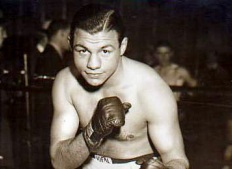Tony Canzoneri: The Poster Child for the Golden Era of New York City Prize Fighters
 By Mike “Rubber Warrior” Plunkett
By Mike “Rubber Warrior” Plunkett
One of the best in a period that churned out many standout fighters, Tony Canzoneri was among the most game, known for his aggression and power.
In a career that spanned just over fourteen years he managed to win titles at featherweight, lightweight and junior welterweight, ultimately engaging in twenty-two championship bouts over a ten year period that was undoubtedly his peak.
Born in Louisiana in 1908, he started boxing as an amateur in New Orleans. Sometime later, he relocated to New York City with his family where ultimately he won the state amateur bantamweight championship in 1924.
Turning professional at age 16 in 1925, Canzoneri was the poster child for the typical fighter of the era, sometimes engaging in three to four bouts per month and easily upwards of 25 matches in a year. He rarely ventured beyond the boundaries of New York, which at the time was widely considered the Mecca of the sport. In his first 38 bouts, all but one were contested in New York with the lone exception being his second professional match which was held in New Jersey.
He spent the next two years honing his craft among hardened men befitting the times. Within that two year span, Canzoneri amassed a busy record of 34-1-4 and was by then seasoned and experienced enough to challenge contender Bud Taylor, 49-5-4, for the vacant NBA bantamweight title.
After two competitive matches with Taylor which resulted in a draw and a loss, he soon ventured beyond bantamweight and began his campaign at featherweight in search of professional glory where he faced off against Hall of Famer Johnny Dundee for the vacant world title.
Canzoneri thoroughly out worked and out boxed the aging Dundee, 84-21-19, to win the championship, after which he lobbied for and ultimately made a pivotal match with NBA featherweight champion Benny Bass looking to unify the title. Canzoneri won a clear-cut decision over Bass and in the process, broke the defending champ’s collar bone. His reign would prove to be short-lived, losing to Frenchman Andre Routis just seven months later in his first title defense. In 1929, Canzoneri moved up to the lightweight division where he managed a title opportunity shortly thereafter.
Losing a ten round decision to defending champ Sammy Mandell, 57-4-3, he continued his campaign onward, having three notable encounters in 1930 and ’31 with Jackie “Kid” Berg, 74-4-5, an equally brave and aggressive fighter that was more than prepared to deal with Canzoneri’s spirited advances. Canzoneri lost to Berg on points in a non-title bout but later stunned the boxing world in 1930 by flattening lightweight champ Al Singer, 53-7-2, in the first round to take the world lightweight title.
So stunning was the win, Canzoneri made it look all too easy taking his second world title in a second weight class by knockout in just 66 seconds. In April 1931, Canzoneri avenged his earlier loss to “Kid” Berg by stopping him in the third round to claim the world junior welterweight title. In their rubber match some months later, he held onto the crown with a fifteen-round unanimous decision. After that, he further staked his claim of greatness, posting a clear decision over Kid Chocolate, 67-3-1, in a key defense of his new title.
In 1932 he lost the junior welterweight title to Johnny Jadick by ten-round decision, winning the Louisiana version of the World Junior Welterweight title back in 1933 with ten-round verdict over the 47-7-4 Battling Shaw. A mere month after regaining that title, he lost it and the World Lightweight title by ten-round majority decision to the great Barney Ross, 45-2-2, a future all-timer who was cutting a swath through boxing history and who would ultimately go on to become a three-division champion.
Three months after that defeat, he would challenge Ross for the second time, this time losing by split fifteen-round decision.
In May 1935 Canzoneri won his last championship when he defeated Lou Ambers for the vacant World Lightweight title that had been vacated by Ross. In both the rematch and later in their rubber match, Ambers would take the lightweight title and successfully defend it against him, effectively ending Canzoneri’s championship run.
He continued boxing professionally until November 1939, at times struggling with but mostly winning against the type of opponent he would have easily out skilled or powered past years earlier when in his fighting prime.
The end came in a bout with then-undefeated Al “Bummy” Davis, a man once named to Ring Magazine’s 100 greatest punchers of all-time, where he was stopped in the third-round after being easily overpowered and dropped twice. It was the only knockout loss of his career and notable in that it came at the very end with an extraordinary puncher when all that remained were remnants of the great, spirited fighter he once was.
Tony Canzoneri indeed exemplifies the tough, stereo-typical New York City prizefighter of the ‘30’s. He powered his way to three world championships in three different weight classes, amassing an overall career record of 137-24-10, 44 KO’s. Today, decades after his death, he is a member of the International Boxing Hall of Fame.

